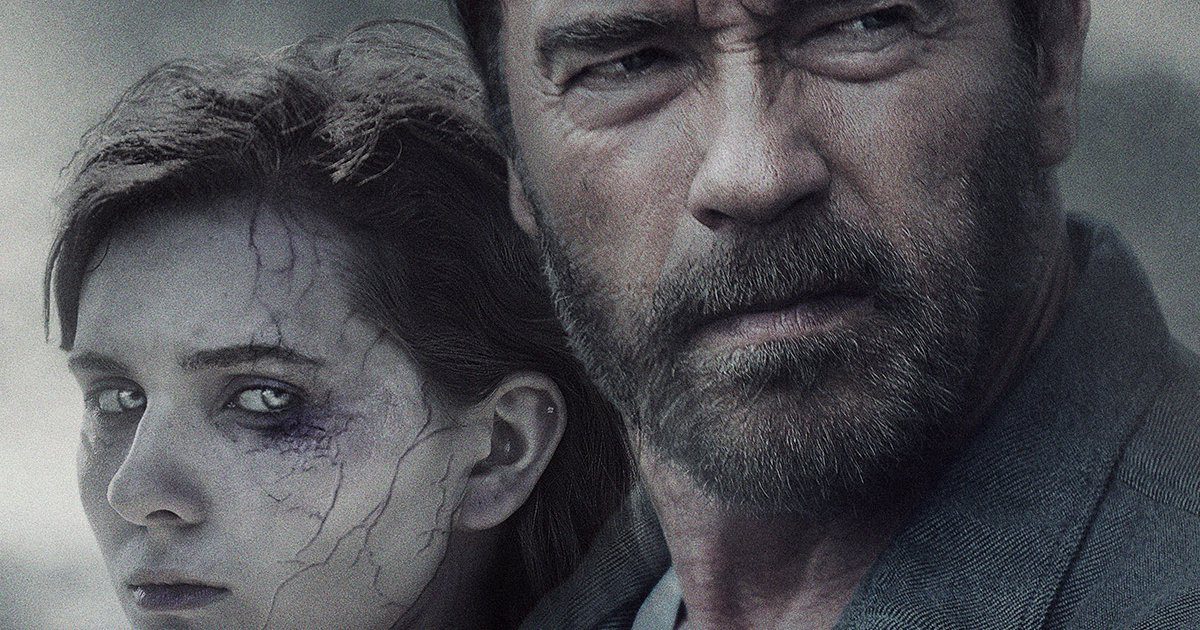 (2.5 / 5)
(2.5 / 5)
As his involvement in Terminator Genisys shows, Arnold Schwarzenegger is not a man who’s afraid to return to the same watering hole.
Over the course of forty years — and almost sixty films — he’s taken on iconic villains like the Predator, the T-1000, and Charles Dance (because screw it, I liked The Last Action Hero), but has so far steered clear of the Universal lineup vis-a-vis Dracula, Mummy, and The Wolfman. The closest he’s come to the supernatural is going mano-e-mano with Gabriel Byrne’s Satan in End of Days back in 1999.
While his latest film sees Schwarzenegger share screen-time with a zombie, undoubtedly the go-to ghoul of the past decade, but he’s not lining up to put a bullet in it, but rather just the opposite. Which is not to say that Maggie is devoid of zombie killing. In fact they go down quite easy, relatively speaking: no bullet to the head required.
The necroambulist virus — no points for subtlety — has swept the Midwest like wildfire, much like the actual fires being used to dispose of infected crops. Its into this Interstellar-esque landscape that Wade Vogler (Schwarzenegger) arrives, driving a pickup.
With his receding hairline dyed black and a neat grey beard, this is the closest The Governator’s come to looking like an ordinary bloke. In fact this may be the closest Schwarzenegger’s come to naturalism: after snapping an undead assailant’s neck he even has the decency to pant a bit.
When his oldest daughter, Maggie (Abigail Breslin), is bitten during an expedition to the city — deserted streets are the order of the day — Wade is left with three options: 1) take her to quarantine at the allotted time, 2) administer a lethal injection at home, or 3) “make it quick”.
Wade elects to spend their final few days together on the homestead, which resembles the 21st Century equivalent of American Gothic. There’s an old whiteboard farmhouse, floral decor, and a gaudy cross on the wall. It’s a world in which dark-haired Maggie, with her tortoiseshell sunglasses and habit of sitting on the roof, feels faintly out of place; making sense of her earlier flight.
By comparison, Wade’s other two kids, by second wife, delicate country rose Caroline (Joely Richardson), are both blonde and angelic-looking.
Director Henry Hobson and writer John Scott III underscore these domestic scenes with a growing sense of dread which is generally more effective than the film’s zombie elements. Coming across a zombified neighbour and infant child out in the woods, Wade pleads with them to answer him, to show any sign of humanity, but Schwarzenegger’s muted performance never quite cuts to the heart of the character’s desperation. Perhaps we’re so conditioned to seeing him solving problems with his fists that it’s difficult to buy him as a man of inaction.
Sun-browned and careworn, Wade often seems uncertain of how to respond to the situation developing around him; it’s to the film’s detriment that I was never sure if this was a deliberate choice or merely a sign of Schwarzenegger’s limited range. Maybe it’s that on full burst, fair or not, his accent tends towards comedy even in the most life-or-death situations — “Get to the choppa!” anyone?
Still, Schwarzenegger really comes into his own in the brief moments of joy behind him and Maggie, like sharing a song on the radio or laughing over terrible cooking.
While Schwarzenegger is content to gently coast on the impression of Wade as a quiet figure of strength, Breslin gets more to work with in the eponymous role. As a teenage girl coming to terms with monstrosity and eventual death, Breslin is still enough of a child that every moment of joy — picking daises in her mother’s garden — or horror — black blood oozing from a cut — instinctively shines through.
Richardson, too, finds pathos as the fragile stepmother seeking to comfort a child of whom she feels increasingly terrified.
Hobson’s directorial debut, Maggie takes its cues not only from the likes of BBC3’s In The Flesh, but also from video game The Last of Us (for which Hobson designed the title card). There’s a similar central relationship at work here, between a strong, silent father type and an infected girl; only here its the girl that is doomed.
Maggie is only released into Wade’s custody because he’s friends with a local doctor and even the local cops, sympathetic Ray (Douglas M. Griffin) and hostile Holt (JD Evermore), consider disposing of the infected as a necessary evil.
Hobson’s style is one of juddering pans and cuts, but it’s not always complimented by Lukas Ettlin’s washed-out cinematography, which provides little contrast to Maggie’s increasingly ghostly appearance. David Wingo’s score, meanwhile, is at its best when most ambient — a background thrum that adds to the tension, as opposed to the plaintive piano that plays into the film’s more maudlin aspects.
Too elegiac to be truly moving, I never truly believed that Maggie’s family will endure the crisis. Maggie’s passing feels like theirs.
Still, given Maggie‘s status the lowest budgeted film he’s appeared in since the original Terminator back in 1984 (or so IMDb would have me believe), it’s comforting to know that the now sixty-eight year-old Schwarzenegger’s career needn’t be curtailed by his continuing ability to battle homicidal cyborgs.
If Clint Eastwood can receive his fifth Best Picture nom at the age of 84, it’d be foolish to count Schwarzenegger out.
